Best SD Cards for Action Cameras in 2025

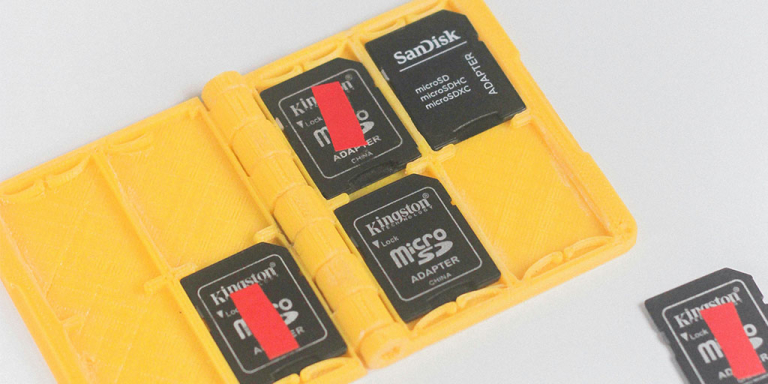
If you're looking to capture high-octane adventures in 4K or 5K resolution, selecting the best SD cards for action cameras is crucial. In 2025, the demand for high-performance microSD cards has surged, driven by content creators and outdoor enthusiasts who need fast, durable, and high-capacity storage.
The best SD card for action cameras must deliver blazing read/write speeds, meet UHS-I U3 and V30 video speed class standards, and withstand the rigors of shock, water, and temperature extremes. Cards that can’t keep up with your camera’s bitrate will result in dropped frames, corrupted files, or total recording failure, which is why choosing one of the best SD cards for action cameras ensures not just performance but peace of mind.
This guide reviews the top-performing options available in 2025. We’ve looked at the best microSD cards for action cameras and ranked them based on speed, reliability, and real-world use cases, so whether you're shooting cinematic 4K footage on a GoPro Hero 12, capturing slow-motion BMX tricks with a DJI Osmo Action, or recording hours of 360° content with Insta360, this roundup has the ideal card for your needs.
We’ve also included current Amazon pricing, warranty information, and a comparison chart to help you make a data-driven decision. All featured cards are rated U3, V30, and most are A2, making them more than capable for demanding video applications.
Read on to find which SD cards you should pair with your action camera and maximize every adrenaline-filled moment.
What to Look for in a SD Card for Action Cameras
Before the recommendations, it’s worth understanding the key factors that make a microSD card suitable for action cameras:
- Speed Class & Video Rating: Minimum write speed is critical. Look for Class 10, UHS-I U3, and V30 labels – these ensure at least 30MB/s sustained writes for 4K UHD video. All the best microSD cards in 2025 carry U3 and V30 ratings (or higher), which prevents dropped frames or recording errors during high-bitrate video.
- Read/Write Performance: Higher sequential read speeds (e.g. 100–160+ MB/s) mean faster offloading of footage to your computer. Fast write speeds (e.g. 90–130+ MB/s) allow the card to handle bursts of 4K, 120fps, or even 5K footage without buffering. We focus on cards with proven high throughput – many of these top out the UHS-I interface. For instance, Lexar’s 1066x Silver series achieved over 180 MB/s writes in testing, exceeding its own specs.
- UHS-I vs UHS-II: Most action cams support UHS-I only. UHS-II microSD cards (which have a second row of contacts for higher bus speeds) will work in UHS-I cameras, but you won’t get extra speed in-camera. All our picks are UHS-I cards, which are more cost-effective and fully sufficient for GoPro, DJI, and similar devices in 2025. (UHS-II and the new microSD Express cards are emerging, but they’re mainly beneficial for devices that explicitly support those modes – no current action camera does, as of 2025.)
- Capacity and File System: Ensure your camera can handle 1TB microSDXC cards. Most modern action cams do (GoPro’s 2024–2025 models, DJI, etc., support exFAT-formatted microSDXC up to 1TB). The benefit of 1TB is fewer card changes; the downside is that if you lose or corrupt a card, that’s a lot of data on one card. Using high-quality, well-reviewed cards and formatting in-camera can mitigate risks.
- Durability & Warranty: Action cams face extreme conditions – shock, temperature, water, and sometimes constant writing. Many cards are built to be waterproof, temperature-proof, shock-proof, and X-ray-proof. Look for those assurances. Also consider the warranty: top manufacturers offer limited lifetime warranties on flash memory (or long fixed terms like 10 years for Samsung). A long warranty indicates the brand’s confidence in the product’s longevity.
- A1 vs A2 Rating: This is the App Performance Class. A2 cards can handle random reads/writes at higher IOPS, which matters if using the card for apps (Android adoptable storage, etc.). For pure video recording, A1 vs A2 doesn’t directly affect footage quality, but A2-rated cards are generally higher-end and use faster controllers and memory, which often correlates with better overall performance. All else equal, an A2, U3, V30 card is ideal for an action cam in 2025.
Now, with these criteria in mind, let’s look at the best SD cards for action cameras this year.
Best SD Cards for Action Cameras in 2025 – Our Top Picks
Below we’ve listed the top SD cards that combine high speeds, reliability, and real-world performance in action cameras. Each entry notes the card’s speed ratings, measured performance where applicable, warranty, and approximate current Amazon price. All these cards are microSDXC UHS-I and have at least U3 and V30 ratings (suitable for 4K). We’ve emphasized cards tested by experts or carrying strong reputations among action cam users.
1. SanDisk Extreme 1TB microSDXC UHS-I
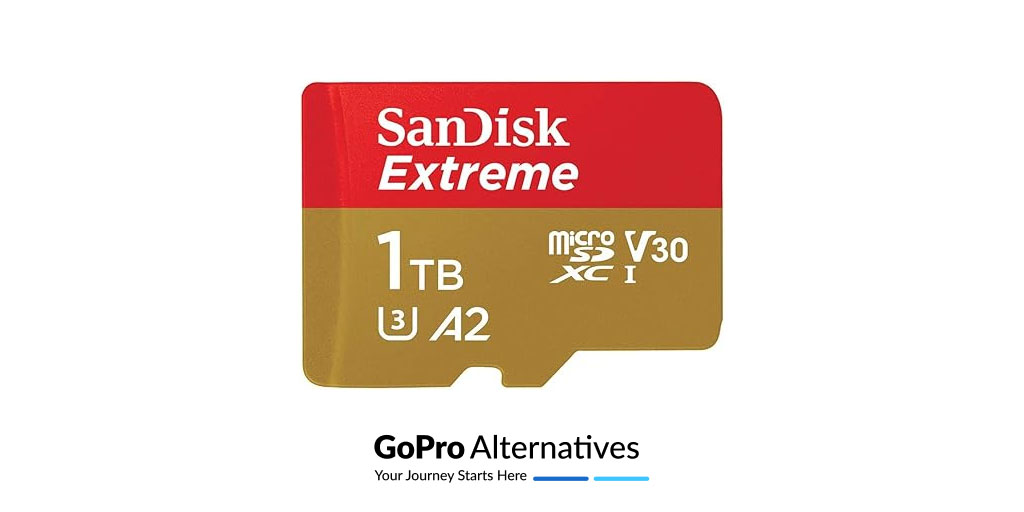
Title: Best Overall SD card for 4K Action Cams
Speed Class: UHS-I U3, V30, A2
Rated Speeds: Up to 190 MB/s read, 130 MB/s write (with SanDisk QuickFlow tech
Warranty: Limited lifetime (in U.S.)
Amazon Price: ~$100 (adapter included)
SanDisk’s Extreme line has been a go-to for GoPro users for years, and the latest SanDisk 1TB Extreme microSDXC continues to impress. It’s optimized for 4K and 5K video recording, carrying the U3 and V30 badges to guarantee 30MB/s minimum sustained writes – crucial for high-bitrate action footage.
In fact, SanDisk touts write speeds of up to 130MB/s on this card, with read speeds of up to 190MB/s when using their proprietary QuickFlow-compatible reader. This means quicker file transfers after a day of shooting (though note that in-camera performance is limited by UHS-I bus ~104MB/s).
SanDisk Extreme 1TB is built for extreme conditions: it’s temperature-proof, water-proof, shock-proof and X-ray-proof. It’s one of the officially recommended cards for GoPro and other action cams due to its reliable performance. In action, it can easily handle 4K UHD at 60fps, and even the GoPro’s 5.3K modes or 240fps slow-motion, without dropping frames. The A2 rating also means it can double as high-speed storage for smartphones or drones, with snappy app loading.
Why it’s great: The SanDisk Extreme offers a balance of high performance and proven reliability. Many creators consider it the “safe choice” for capturing critical moments. It comes with a limited lifetime warranty, showing confidence in longevity. If you want a single card that you can trust for a big adventure trip, the 1TB Extreme is hard to beat.
Tech reviewers often use SanDisk Extreme as a benchmark; it consistently ranks among the best microSD cards for any application. And with prices around the $100 mark for 1TB, it’s also competitively priced per GB in 2025.
Note: SanDisk also sells an Extreme Pro microSD (often black/red label) with slightly higher top-end speeds (advertised up to ~200MB/s read and 140MB/s write). However, in practice, Extreme and Extreme Pro perform very similarly in UHS-I devices. The Extreme 1TB is more widely available and usually cheaper, making it the better value for action camera use.
2. Samsung PRO Plus 1TB microSDXC
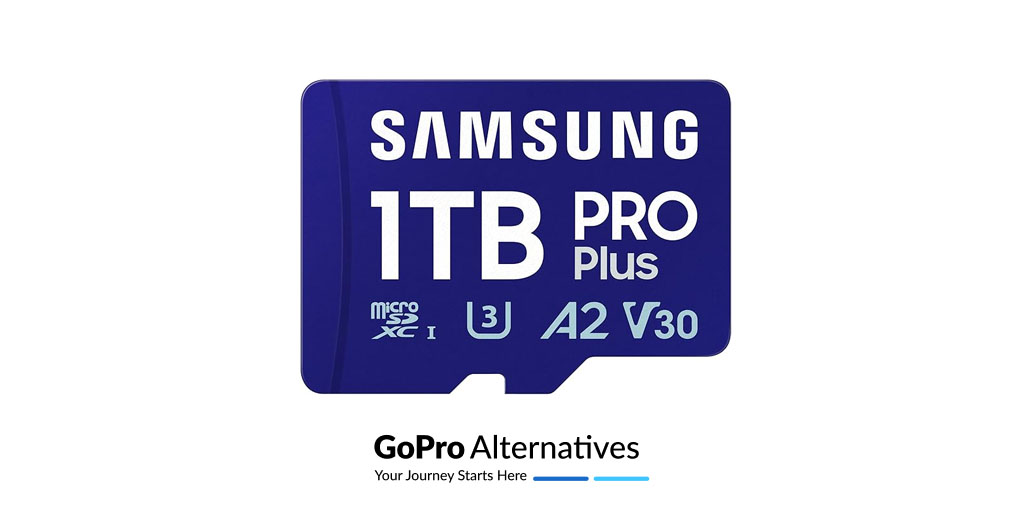
Title: High Performance with 10-Year Warranty
Speed Class: UHS-I U3, V30, A2
Rated Speeds: Up to 180 MB/s read, 130 MB/s write
Warranty: 10-year limited (Samsung USA)
Amazon Price: ~$90 (often on sale)
Samsung was a bit late to the microSD party, but with the Samsung PRO Plus 1TB (released in 2024), they delivered a top-tier contender.
The Samsung PRO Plus is all about consistency and durability – it’s designed for intensive use in drones, action cams, and smartphones. It comes with Samsung’s hallmark 6-proof protection (water, temperature, X-ray, magnet, drop, and wear resistance).
With sequential speeds up to 180MB/s read and 130MB/s write, it’s one of the fastest UHS-I microSD cards on paper. In practice, those speeds enable smooth recording of 4K UHD video and quick file transfers. The card easily meets U3/V30 requirements (Samsung explicitly advertises the Pro Plus for 4K UHD and super slow-motion recording).
One standout feature is the 10-year warranty Samsung provides – a testament to the company’s confidence. That’s about as long as one could realistically use a flash memory card, making it ideal for users who plan to reuse the card across multiple cameras and devices over the years. The PRO Plus is also A2-rated, so it excels in random read/writes (e.g., if you use it in an Android device or to store many small files).
In an action camera, the Samsung PRO Plus performs flawlessly. It keeps up with GoPro Hero 12/13 Black recording at 4K60 and with DJI’s high-bitrate modes. It also has a slightly higher sustained write speed than Samsung’s EVO series (below), giving extra buffer for data spikes (like when shooting dynamic scenes or rapid photo bursts). If you often push your gear to the limits – say, continuous recording in hot environments – the PRO Plus is a robust choice.
Why it’s great: Samsung’s flash memory expertise shows here – the PRO Plus offers excellent speed and reliability on par with SanDisk’s Extreme Pro. It’s a top pick for professionals who need that added peace of mind (with the long warranty and Samsung’s quality control).
Despite being a premium card, it’s often discounted around ~$90 for 1TB, which is fantastic value. Samsung even launched a special Sonic the Hedgehog edition of this card (with identical specs) in early 2025, underscoring how it’s being pushed to gamers and content creators alike. For action cam users who want one of the fastest and toughest cards available, the Samsung PRO Plus 1TB is a wise investment
3. Lexar Professional 1066x Silver Series 1TB microSDXC
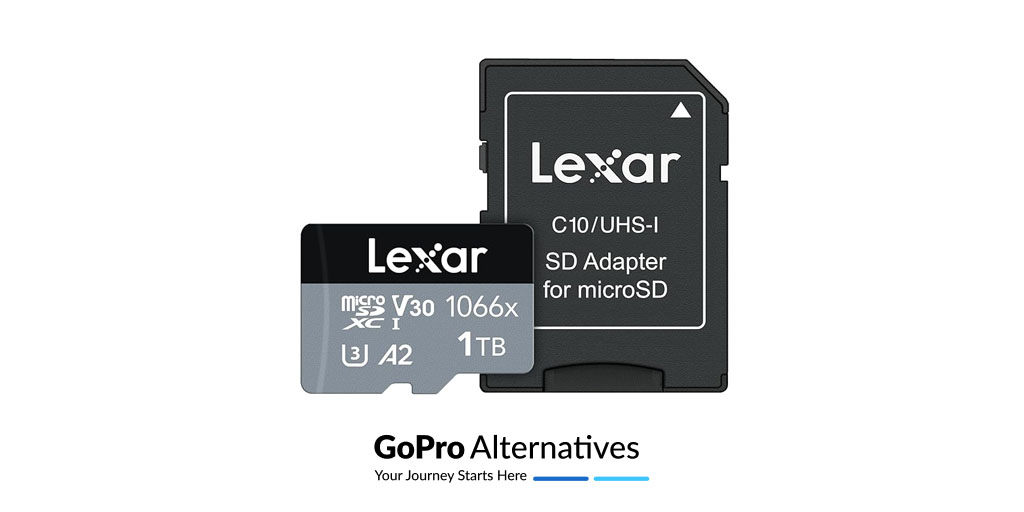
Title: Fastest Read/Write Speeds in Class
Speed Class: UHS-I U3, V30, A2
Rated Speeds: Up to 160 MB/s read, 130 MB/s write (tested beyond this)
Warranty: Limited lifetime (10-year limited in regions that don’t allow lifetime)
Amazon Price: ~$95 (often around $90 on sale)
Lexar’s Professional 1066x Silver Series (sometimes dubbed “Silver Plus” in reviews) has emerged as one of the fastest UHS-I microSD cards on the market. Aimed at action cameras, drones, and DSLR/mirrorless users, the 1TB version combines huge capacity with blazing speed.
Officially, it’s rated for 160MB/s reads and 130MB/s writes – right up against the UHS-I theoretical limits. In real-world benchmarking, TechRadar’s tests found the Lexar 1066x actually exceeded those specs, reaching ~205 MB/s read and 182 MB/s write in certain tests. This means the card not only clears the V30 hurdle comfortably, but has headroom to spare – a boon for offloading large 4K video files or shooting high-res burst photos.
For action camera use, the Lexar Professional 1TB provides smooth 4K recording and is well-suited for high-frame-rate modes. It’s U3 and V30 rated of course, and also A2-rated for high performance. What sets it apart is that extra speed margin – if you use a USB 3.2 UHS-II card reader, you can dump footage significantly faster than with cards capped at around 90-100MB/s. Lexar’s card is also built tough: it’s marketed as durable in extreme conditions (water/shock/vibration resistant), and all cards undergo extensive testing in Lexar’s labs.
Why it’s great: For pure performance, the Lexar 1TB Silver Series is a star. It’s often cited as overengineered for what most consumer devices need, which is good news for users who want a bit of future-proofing. In an action cam, you won’t necessarily notice a difference vs. other top cards during recording, since all these cards meet the 4K requirement, but you may notice faster file transfers and perhaps slightly less drop in speed as the card fills up. Lexar managed to balance speed and capacity without breaking the bank; the card is usually priced competitively against SanDisk and Samsung.
With a limited lifetime warranty (in the US) to back it, it’s an excellent choice if you want the fastest 1TB microSD card for your GoPro or drone. Many reviewers have called it a “great solution” for expanding action camera storage, highlighting that its performance even exceeded expectations in testing.
Note: The Lexar Professional series was historically well-regarded by professionals (Lexar introduced the first 1TB SD card back in 2019). After a change in ownership, Lexar’s new products,like this 1066x have proven themselves in independent reviews. Just be sure to buy from a legitimate source, as counterfeit high-capacity Lexar cards can appear due to the brand’s popularity.
4. Kingston Canvas Go! Plus 1TB microSDXC
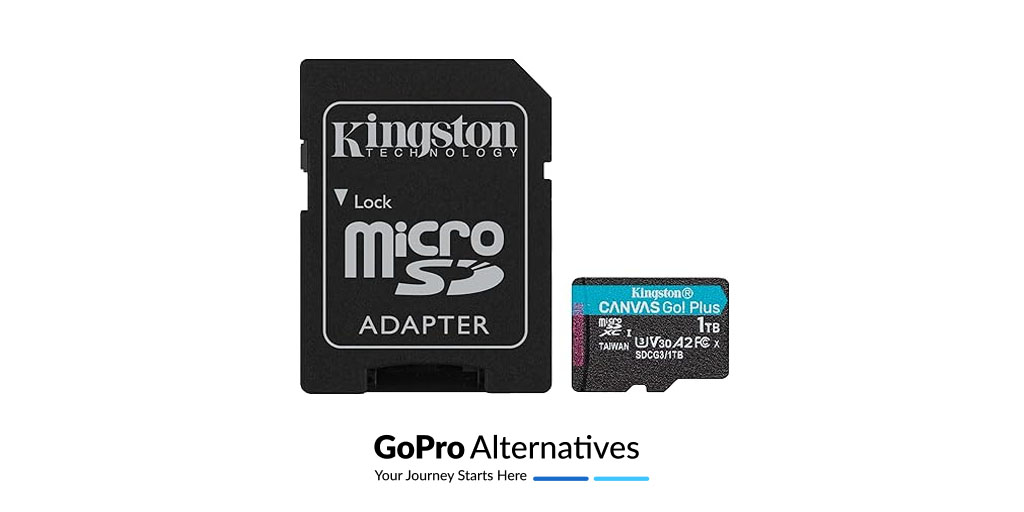
Title: Reliable 4K Performer for Action Cameras
Speed Class: UHS-I U3, V30, A2
Rated Speeds: Up to 170–200 MB/s read (varies by reader), 90 MB/s write
Warranty: Lifetime limited warranty
Amazon Price: ~$90
Kingston’s Canvas Go! Plus series is built “for adventurers”, and it shows in the design and specs. The 1TB Canvas Go! Plus is a high-speed card tailored to action cams, drones, and mobile gaming. It carries the necessary U3 and V30 ratings for 4K recording and is A2-rated for snappy app performance. Kingston advertises read speeds up to 170MB/s on the microSD (which can reach 200MB/s on the full-size SD version of Canvas Go! Plus using a UHS-II reader).
Write speeds are around 90MB/s for the microSD, which is on par with other top cards. In real usage, this means the Canvas Go! Plus easily handles GoPro’s 4K60 and 5K30 modes and high-bitrate video, and it keeps pace when taking bursts of 20MP+ stills on a drone or DSLR (with adapter).
The Canvas Go! Plus is rugged: it’s tested to be waterproof, shock and vibration proof, x-ray proof, and temperature proof – all essential for withstanding the rigors of outdoor action camera use. Kingston is known for solid memory products, and this card is no exception. With a limited lifetime warranty backing it, you can trust it for the long haul.
One advantage with Kingston is broad compatibility – these cards play nicely with essentially any device that supports microSDXC. Users have reported the 1TB Canvas Go! Plus works flawlessly in GoPro HERO9/10/11/12, DJI Osmo Action, as well as in gaming devices like the Nintendo Switch (though for Switch use, the focus is more on capacity). For our context of action cameras, the Canvas Go! Plus offers consistently fast writes that prevent recording issues.
Why it’s great: The Kingston Canvas Go! Plus is a no-nonsense workhorse. It may not always top the charts in raw benchmarks (its write speed ~90MB/s is a tick behind the likes of Samsung Pro or Lexar on paper), but it delivers where it counts – stable 4K video capture and fast reads. Many content creators appreciate Kingston for its reliability and the lifetime warranty – essentially, Kingston stands behind the card as long as you own it.
The price of the 1TB model has become quite reasonable, often around $85–$95. If you’re expanding your arsenal of memory for multiple cameras, the Canvas Go! Plus is a great choice to ensure each device has a dependable card. It’s especially appealing if you’ve had good experiences with Kingston in the past and want a card that “just works” in the field.
5. PNY Pro Elite 1TB microSDXC
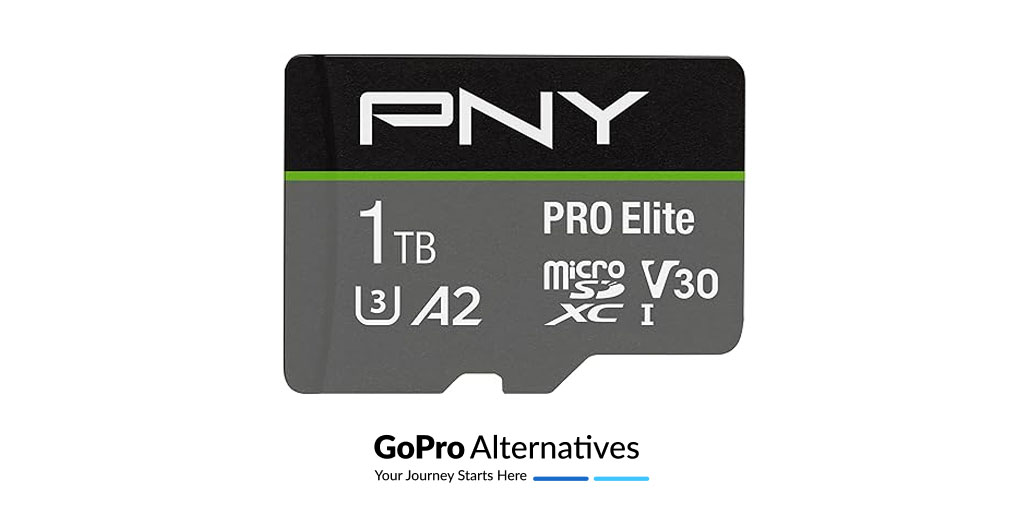
Title: High-Capacity Card with Solid Performance, also Best Value Option
Speed Class: UHS-I U3, V30, A2
Rated Speeds: Up to 100 MB/s read, 90 MB/s write (Pro Elite series)
Warranty: Lifetime limited warranty
Amazon Price: ~$70 (frequently on sale)
If you’re looking for a slightly more budget-friendly 1TB card that still meets all the performance needs of an action camera, PNY’s Pro Elite 1TB is worth considering. PNY is a U.S.-based memory manufacturer that has been around for decades, and their Pro Elite microSD line targets high-end usage (photography, 4K video, etc.) without the premium price of some bigger brands. The Pro Elite 1TB is rated U3/V30, guaranteeing those crucial sustained speeds for 4K recording, and is also A2-rated. Its advertised speeds (about 100MB/s read, 90MB/s write) are a bit lower than some competitors – it doesn’t boast 150+ MB/s reads – but in practice 100MB/s is more than enough for action cams, which typically require at most ~60-90 Mbps (7.5–11 MB/s) for 4K video streams.
In camera usage, the PNY Pro Elite handles 4K video without hiccups – the 90MB/s write ceiling is well above the threshold needed, providing a buffer for any spikes. The slightly lower read speed means offloading files might be a tad slower than, say, with a Lexar or SanDisk Extreme, but the difference for say 30GB of footage might be only a minute or two in real terms. For most users, that’s an acceptable trade-off given the cost savings. As of 2025, the 1TB Pro Elite often sells for considerably less than $100; we’ve seen it around $70-75 on Amazon, making it one of the cheapest brand-name 1TB microSD cards with V30 capability.
Despite the lower price, PNY doesn’t skimp on quality: the Pro Elite is magnet-proof, shock-proof, temperature-proof, and waterproof as well. It’s a popular choice for dash cams and security cams too, which means it can endure continuous writing. PNY offers a limited lifetime warranty on the standard Pro Elite series, so you’re covered in case of any failures (they also have a separate High Endurance line with shorter warranty, but note this Pro Elite 1TB is the performance line).
Why it’s great: PNY Pro Elite 1TB strikes a great balance for hobbyist action cam users or anyone on a budget. You get a full 1TB of space and reliable V30 performance at a lower cost-per-gigabyte. If you need to buy multiple cards (perhaps for a multi-cam setup or to have spares), going with PNY can save a significant amount compared to the top-tier flagships, without sacrificing the ability to record high-quality video. It’s essentially a value pick – you still get the critical specs like U3/V30 and a lifetime warranty, just with slightly lower peak speeds.
For many, that’s an acceptable compromise. In real-world usage with a GoPro or similar, you likely won’t notice a difference in recording quality versus more expensive cards – your footage will be just as smooth. The only time you might wish for a faster card is when transferring lots of files, but even then the Pro Elite’s ~100 MB/s read is respectable. Overall, it’s one of the best microSD cards for action cameras (2025) in terms of bang for your buck.
Comparison Table: Best 1TB microSD Cards for Action Cameras (2025)
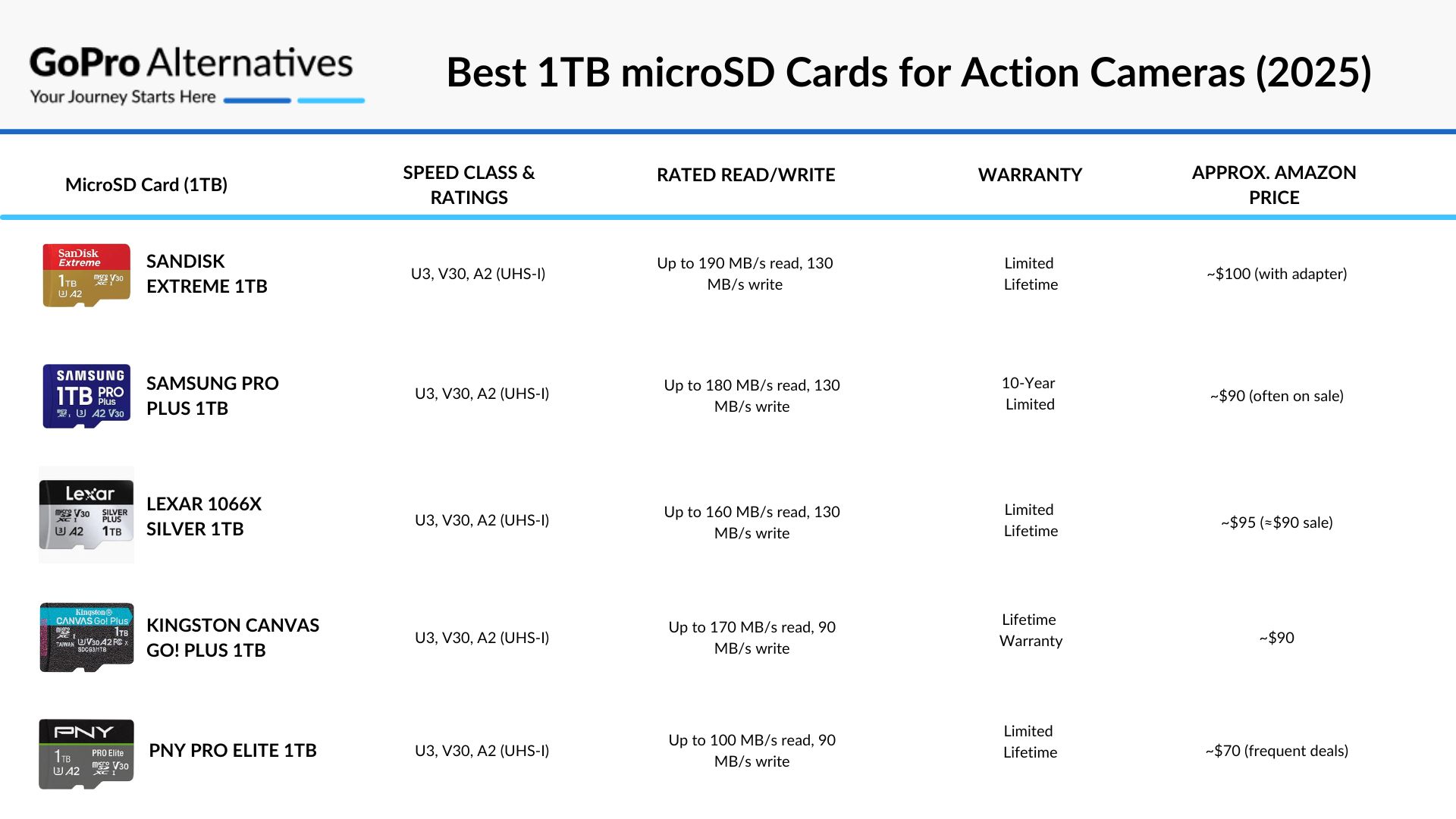
All the above cards are microSDXC UHS-I and support exFAT for >32GB. Prices are in USD and current as of mid-2025; they may fluctuate with discounts.
Each of these cards will serve you well in an action camera. The “best” choice ultimately depends on your priorities – whether it’s maximum speed (Lexar, Samsung), trusted name and balance (SanDisk, Kingston), or value for money (PNY). With any of them, you’ll be able to record high-quality footage on your GoPro, DJI, Insta360, or other action cam with confidence.
Final Thoughts
In conclusion, 2025’s best SD cards bring tremendous storage and performance to your action camera. Based on performance benchmarks, durability, compatibility with action cameras, and value in 2025, the SanDisk Extreme 1TB microSDXC UHS-I stands out as the best SD card for action cameras overall.
But, whether you choose the all-around excellence of the SanDisk Extreme, the high-speed and durable Samsung/Lexar options, or the value-packed PNY cards, you’ll be equipped to record every epic adventure in stunning detail. High-capacity microSD cards have truly come of age, letting us focus on the action, not on swapping memory cards.
Happy shooting!
Featured image by Fran Jacquier.
FAQ
Can action cameras really use 1TB microSD cards?
Yes. Most modern action cameras (2020 and later) support microSDXC cards up to 1TB, thanks to exFAT file system support. For example, GoPro’s Hero 11/12 and the DJI Osmo Action series officially support 1TB cards. Always check the manufacturer’s specs: older models might list lower “max” capacities simply because 1TB cards didn’t exist during testing, but in many cases they will still work if formatted correctly.
In 2025, using a 1TB card in a GoPro or similar is generally plug-and-play. Just be sure to format the card in-camera before use. If a camera was released many years ago (and only supports FAT32), it may cap out at 32GB; but any action cam recording 4K (which requires exFAT for file sizes) will accept 1TB.
How many hours of footage can a 1TB microSD card hold in 4K?
A 1TB card can hold a lot of footage. It depends on the camera’s bitrate. As a rough estimate, 1TB (which is about 931GB usable) can store around 40–50 hours of 4K UHD video at standard action cam bitrates. For instance, Samsung calculated that 1TB can store about 47 hours of 4K UHD video. If you’re shooting 4K at 60fps or high bitrate (e.g., Protune or 100Mbps), the hours will be a bit fewer (perhaps ~25–30 hours). Even at the highest quality settings (say 5.3K video on a GoPro Hero 12), you’re looking at tens of hours of footage.
In other words, you could record all day, every day of a week-long vacation on one card. Keep in mind that battery life and camera overheating will stop you long before the card fills in one go. Always factor in some buffer and remember to offload footage regularly – it’s not wise to keep all your trip’s footage on a single card without backups, despite the temptation.
What do the ratings like U3, V30, A2 mean on microSD cards?
These are speed and performance classes:
- U3: Stands for UHS Speed Class 3, which means the card supports a minimum sequential write of 30 MB/s. This is essential for 4K video. (By contrast, U1 means 10 MB/s; too slow for 4K.) All cards we recommended are U3.
- V30: This is the Video Speed Class rating, also indicating 30 MB/s minimum sustained write specifically for video recording. V30 is effectively the same threshold as U3. Some higher-end cards might be V60 or V90 (60 or 90 MB/s minimum), but those are usually UHS-II cards – most UHS-I cards top out at V30. For action cams, V30 is sufficient because even 5K video (~100 Mbps) is ~12.5 MB/s, well under 30 MB/s. V60/V90 are overkill for these devices (used more in cinema cameras or shooting high bitrate 8K).
- A2: This is the Application Performance Class 2. It means the card can handle at least 4000 IOPS read and 2000 IOPS write (random IO) with a certain minimum sustained performance. In practical terms, A2 cards load apps and files faster on smartphones or devices that use adoptable storage. For an action camera, A2 isn’t critical for video, but A2 cards tend to be higher spec models with better controllers, which coincides with better overall performance. A1 (App Performance Class 1) is a step down (1500/500 IOPS). If you plan to use the microSD in devices like an Android phone, Steam Deck, or drone (for more than just video), A2 is preferable. But for pure camera recording, focus on U3/V30 first – that guarantees video write speed. All the top picks above are A2 except the TeamGroup GO 1TB (A1), but it’s still U3/V30 so it records video just fine.
In summary, U3 and V30 are must-haves for action camera microSD cards in 2025. A2 is a nice bonus that often comes with higher-end cards (and usually those cards have great sequential speeds too). Always check these ratings on a card before buying – avoid anything that’s U1 or V10/V20 if you intend to shoot 4K.
Is it better to use one large 1TB card or multiple smaller cards (e.g. 256GB x4) for action footage?
This comes down to personal workflow and risk tolerance:
- Using one 1TB card means you don’t have to swap cards during the day. This is super convenient (no missed moments due to a full card, less chance of dropping or losing a tiny microSD during a swap). It’s especially useful for activities like diving, skiing, or driving, where you might not be able to change cards easily. The downside is “all your eggs in one basket” – if the card fails or you lose the camera, you could lose a huge amount of footage.
- Using multiple smaller cards (say one per day or one per session) can compartmentalize your data. If one card gets lost or corrupted, you haven’t lost everything. Also, transferring files in smaller batches is sometimes easier on older computers. Some people shooting professionally swap cards to create backups on the fly (fill one card, store it safely, use a fresh card, etc.).
In 2025, 1TB cards have proven to be quite reliable, and all the major brands have low failure rates. If you use a high-quality card (like the ones we listed) and handle it properly, the risk of failure is low – so using a single 1TB is fine and very convenient. Just ensure you back up your footage whenever you have a chance (carry a portable SSD or use cloud backups when possible).
For critical shoots, a common strategy is to rotate between two cards (record on Card A in the morning while Card B backs up to a drive, then swap). For casual use, it’s mostly about convenience, and one big card is great. Just avoid filling any card to 100% – leaving a few GB free can help with wear leveling and performance.
Are higher capacity microSD cards (like 1TB) less reliable than lower capacity ones?
Not inherently. Early on, when 1TB cards were new (around 2019–2020), they were extremely expensive and somewhat untested. But now in 2025, 1TB microSD cards use mature flash memory technology. The reliability of a microSD card has more to do with the flash memory quality and controller design than the capacity itself. All the cards we recommended come from top manufacturers who use quality components. In fact, some 1TB cards (e.g., from Micron or SanDisk) use industrial-grade memory that can be very robust. The main concern with any large card is the impact of a failure – if a 32GB card fails, you lose less data than if a 1TB card fails. But failure rates for good cards are quite low.
One thing to watch is counterfeit cards. Because 1TB is a marquee capacity, there are fake cards (especially sold on dubious online marketplaces) that claim to be 1TB but are actually smaller cards reprogrammed. Always buy from reputable retailers. A genuine card from SanDisk, Samsung, Lexar, etc., will have the advertised capacity and should last for many write cycles. Many have TBW (terabytes written) endurance far beyond what an action cam would ever write in its lifetime.
To maximize reliability: format the card in the camera periodically, avoid extreme heat (don’t leave the card baking in direct sun), and don’t let it totally fill up if you can avoid it. Also, use the “Safely eject” when removing from a computer to prevent file system corruption. In summary, a 1TB card from a good brand is just as reliable as smaller cards in 2025 – and all come with long warranties (5 years to lifetime) to back that up.
Should I use a UHS-II or microSD Express card for my GoPro?
No need. Current GoPro and similar action cameras do not support UHS-II or microSD Express modes – their slots are UHS-I, which maxes out around 104 MB/s bus speed. Using a UHS-II microSD (which often is labeled V60 or V90) will still work (they’re backward-compatible and will behave as a UHS-I card in the camera), but you’ll have paid a lot more money for speed that the camera can’t utilize while recording. You might gain a benefit when offloading to a computer if you have a UHS-II reader – transfers could be faster. However, many UHS-II microSD cards are geared toward professional photography and can cost 2-3× the price of an equivalent UHS-I card. Unless you absolutely need the fastest offload times, it’s hard to justify that extra cost for action cam use.
As for microSD Express – that’s a newer standard using the PCIe/NVMe interface on a microSD form factor (basically turning it into an SSD in your camera). At the time of writing, microSD Express cards are very niche, and no action cams support the Express interface. They would default to UHS-I mode as well. MicroSD Express shines for devices like the hypothetical next-gen consoles or cameras that could use its >300 MB/s speeds. It’s not relevant to GoPro or DJI users yet. In fact, the world’s first 1TB microSD Express card was just introduced by Lexar in late 2024, primarily eyeing devices like the future Switch 2 or high-end video rigs. So, for now, stick to a good UHS-I U3/V30 card – it’s the best SD card for GoPro action cameras in terms of compatibility and value. Save your money and invest in additional batteries or accessories instead!
How can I avoid fake or subpar microSD cards when buying online?
This is a great question, since the market does have counterfeits. To ensure you get a genuine, high-quality card:
- Buy from reputable sellers: On Amazon, purchase “Sold by and shipped by Amazon” or from the official brand store if possible. Avoid suspiciously cheap listings from unknown sellers (e.g., a “1TB SanDisk” for $20 is absolutely fake). Authorized retailers or the manufacturer’s own website are safest.
- Check the packaging and label: Genuine cards come in branded packaging with holograms or proper UPC codes. The card itself should have a printed label (not a cheap sticker) with the brand and capacity clearly marked. If anything looks low-quality or the print is blurry, it might be fake.
- Test the card on arrival: Use software like h2testw or FakeFlashTest on a PC to verify the actual capacity and speed. These tools write to the entire card to ensure it really stores 1TB of data. A fake card might say 1TB on your PC but only have 32GB of real storage, causing data loss when it “wraps around”. Running a full test will catch this. It’s a good practice, even with authentic cards, to ensure there are no defects.
- Check for reviews: If buying from an online listing, read reviews (especially the 1-star ones) for any red flags about fakes. Sometimes, users will report if they received a counterfeit. Stick to listings with a solid track record.
- Price sanity check: If the price is dramatically lower than every other listing, be wary. While we love a good deal, extremely low prices on high-capacity cards are a red flag. In 2025, a genuine 1TB microSD from a top brand will typically be in the $70–$130 range, depending on sales. Anything far below that could be too good to be true.
By following these steps, you’ll greatly reduce the risk of ending up with a dud card. All the cards recommended in our list above are from well-known brands that have reliable distribution channels. Stick to those, and you can confidently capture your action moments without worry.
